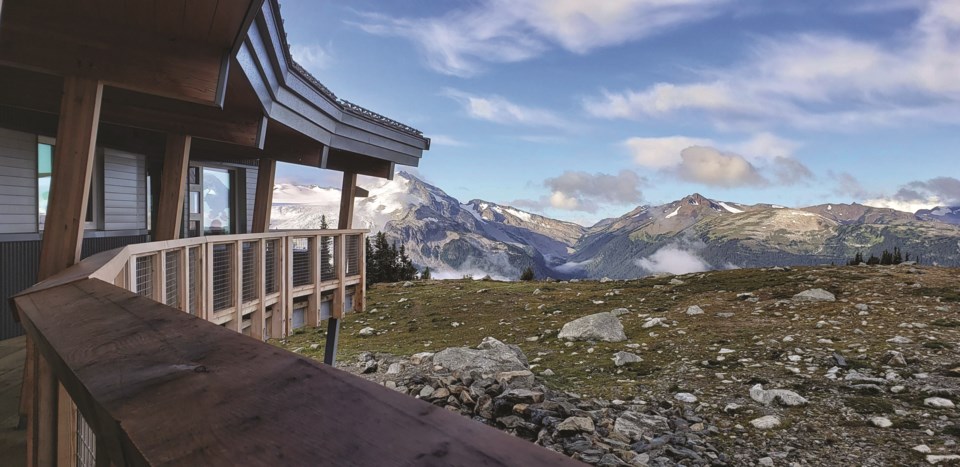First recognizing that I was late to the party, last week I finally got to experience the first of the three Spearhead Huts, the Kees and Claire Hut, located a short walk uphill from Russet Lake in Garibaldi Provincial Park. While the official opening happened back in September, 2019, after a long road of permitting, fundraising and building during busy wildfire seasons, the Spearhead Huts Society then had to contend with COVID-19 health mandates, effectively closing the hut to regular bookings for the next year and a half. A couple of weeks ago it opened up once again for regular bookings.
Spotting incoming rain with a 2,000-metre freezing level in the forecast, my partner and I thought it was a great opportunity to leave the tent at home and check out the finished product of so many years of hard work by dedicated volunteers.
We hiked out via Whistler Peak, travelling along the Mathew’s Traverse road to Harmony then turning onto High Note Trail (via a short section of Half Note connector) to enjoy the views of Cheakamus Lake. We then merged onto the Musical Bumps Trail and entered Garibaldi Park, finally merging onto Singing Pass Trail, which took us up the final climb up Cowboy Ridge to the doors of Kees and Claire. The GPS logged a distance of 10.3 kilometres and the trip out there took about three and a half hours with a short break for lunch.
The first thing that struck me about the hut was its architecture. The two-storey, 2,500-square-foot building sweeps along the contour of the ridge, the sloping roof as aesthetically pleasing as it is practical. The front stairs lead up to a spacious viewing deck that looks back over the Musical Bumps and distant glaciers and peaks of Garibaldi Park. Props to West Vancouver architect Don Stuart for this impressive Passive House design.
Entering on the second floor, a spacious mud room lets you sit down to pull off your sweaty hiking boots and slide right into a pair of comfy hut Crocs. A door to the right leads to the common area, encompassing a large kitchen, dining/socializing area and a lounge with a cozy propane fire heater. The signature feature of this room is the windows, which rise from waist height almost all the way to the ceiling, bathing the entire floor in natural light and providing views of Fissile and Whirlwind mountains above and Russet Lake below. Practical features such as USB charging ports and enough kitchen space for multiple groups to cook concurrently would easily accommodate a full house of 38 guests, though the night we stayed there was under half that many.
The lower floor is designated for sleeping with each alcove sleeping up to either six or eight people. It’s cool down there (the propane heating system keeps it at an energy-efficient 5- to 7-degrees Celsius) so a decent sleeping bag is still required. It’s unlike the balmy lofts of the other firewood-heated huts in the Sea to Sky, but the bunks are solid and there’s more than enough cubby space for backpacks and gear.
The heating, cooking and power generation all relies on three 380-litre propane tanks that need to be flown in and out by helicopter. Winter puts an additional strain on the propane supply since snow needs to be melted for drinking water. The Spearhead Huts Society is trying to curb the costs of moving all that propane in the long run by constructing a water well and installing a solar power system that can power the hut’s lights and charging stations. That project is currently seeking donations, which you can find more information about at spearheadhuts.org.
The water supply during summer months relies on good old-fashioned lake water (sterilized thereafter by boiling or chemical additives). Since the lake is a 10- to 15-minute hike down the hill, there are a couple of backpack frames guests can use to carry a five-gallon (19L) jug back up to the hut. As I experienced, a near-full jug starts to feel pretty heavy after a big day of hiking, so fill your jug accordingly.
Eating a simple pasta dinner that night and looking out the window at the swirling clouds, I had to hand it to the army of volunteers, labourers and fundraisers that made this hut happen. It treads the line between rustic simplicity and European alpine luxury, looks amazing and everything feels like it’s built to endure many decades of use. I’ve waxed poetic plenty about the benefits of having three such structures along the Spearhead Traverse, but after spending the night in one, I finally understood just how ambitious the project is.
Five Stars.
Vince Shuley will be attending the next Spearhead Huts fundraiser. For questions, comments or suggestions for The Outsider email [email protected] or Instagram @whis_vince.




